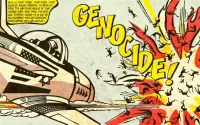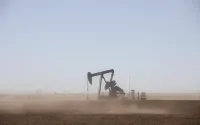Common Dreams / Published on Thursday, September 21, 2006 by the Inter Press ServiStephen Leahy
Another giant ozone hole has opened up over the Antarctic, while evidence mounts that 20 years of international efforts have finally helped the atmosphere to start to heal itself. The "hole" over the South Pole -- actually an annual thinning of the ozone layer, which protects Earth from the sun's ultraviolet radiation -- measured about 24 million square kilometres, nearly the size of North America, according to the Sep. 8 estimate by the renowned British Antarctic Survey, a scientific organisation that has been studying the region for the past six decades.
 This 2001 NASA image depicts the hole in the ozone layer over Antarctica. Earth's protective ozone layer, which was notably thinning in 1980, may be fully recovered by mid-century, climate scientists said on Wednesday. REUTERS/NASA Goddard Space Flight Center (NASA-GSFC)/Handout This 2001 NASA image depicts the hole in the ozone layer over Antarctica. Earth's protective ozone layer, which was notably thinning in 1980, may be fully recovered by mid-century, climate scientists said on Wednesday. REUTERS/NASA Goddard Space Flight Center (NASA-GSFC)/Handout |
The ozone hole will continue to grow and likely be one of the larger and "deeper" ones, perhaps 28 million square kilometres, predicts Andrew Klekociuk of the Australian government's Antarctic Division. The largest ever recorded was 30.3 million sq km in 2000, according to NASA, the U.S. space agency. However, using satellite and ground-based atmospheric ozone measurements, scientists at the Georgia Institute of Technology in the U.S. found that the ozone layer is finally beginning to recover above the mid-latitudes in both the Northern and Southern hemispheres. "We know from the study we've just published that the Montreal Protocol (1987) -- the first major global agreement related to atmospheric change -- is working," Derek Cunnold, a professor of earth and atmospheric sciences at the institute, announced in a Sep. 9 statement. The Montreal Protocol, signed by 184 nations, was designed to return the ozone layer to normal by phasing out use of CFCs (chlorofluorocarbons) and nearly 100 other chemicals that break down the three-oxygen ozone molecules in the Earth's atmosphere. The ozone layer covers the entire planet at an altitude of between 15 and 30 kilometres, and protects all living organisms from the sun's harmful ultraviolet rays. In mid-August, the World Meteorological Organisation (WMO) and the United Nations Environmental Programme (UNEP) released a summary from 250 atmospheric scientists that agreed that the ozone layer is recovering, but at a much slower pace than previously believed. The layer is predicted to be back to pre-1980 levels by 2049 over most of the world, five years later than the previous estimate made in 2002. In the Antarctic region, however, recovery will be slower, likely not before 2065, says the report. "The delayed recovery is a warning that we cannot take the ozone layer for granted and must maintain and accelerate our efforts to phase out harmful chemicals," said Achim Steiner, UNEP executive director, in a statement issued in Geneva and Nairobi. The continued expansion of the ozone hole over the South Pole remains a cause for concern, as does the ineffectiveness of monitoring ozone-depleting substances. "There is no reason to celebrate. The Antarctic hole is as big as ever and the Earth is being exposed to unprecedented levels of ultraviolet radiation," says Alexander von Bismarck, of the non-governmental Environmental Investigation Agency (EIA), with offices in Washington and London. "We still don't know the full impacts of this exposure," von Bismarck told Tierramérica, adding that he has "very serious concerns about the roadblocks ahead" for a continued recovery, including the smuggling of ozone-depleting chemical products. The EIA has conducted undercover investigations into the illegal importation of millions of kilos of CFCs, mainly from China into the United States and other countries. China has promised to investigate after EIA provided videotape evidence this year of Chinese chemical company officials explaining how they mislabel and misdeclare products for import into countries where they are banned, von Bismark said. "Its clearly very difficult to control production of CFCs in China," he added. According to the terms of the Montreal Protocol, developing countries are to phase out CFCs by 2010. In addition to contraband ozone-depleting chemicals, also of concern is the Protocol's "critical use exemption", which allows such chemicals as the pesticide methyl bromide. In 2005, the United States lobbied furiously for -- and obtained -- the exemption for use of nearly 10 million kg (23 million pounds) of methyl bromide -- far more than the rest of the world combined. This year, the United States is permitted to use and manufacture eight million kg. "U.S. methyl bromide use will have a greater impact on the ozone layer than all the CFCs produced in the rest of the world," said von Bismark. The Montreal Protocol is considered one of the most successful international environmental treaties, in part because the world acted to phase out CFCs, and the chemicals HCFC (hydrochlorofluorocarbon) and HFC (hydrofluorocarbon) were quickly found as substitutes for the former uses of CFCs. But even though these chemicals deplete less ozone, they are extremely potent greenhouse gases -- 1000 to 10,000 times worse than carbon dioxide --, contributing to global climate change. HCFCs, better known as the R-22 refrigerant, is used in virtually all home, automobile and commercial air-conditioning systems. The production levels of this chemical has skyrocketed worldwide, and particularly in China, said von Bismark. "As it stands, the global warming impact of world HCFCs and HFCs emissions will rival the total greenhouse gas emissions of the entire European Union within ten years," predicted the expert. An EIA report estimates that by 2015 the HCFCs and HFCs will add the equivalent of 3 billion tonnes of carbon dioxide to the atmosphere -- two to three more times than all the reductions of greenhouse gases under the Kyoto Protocol on climate change. HCFCs are not slated to be phased out until 2040. (*Stephen Leahy is a Tierramérica contributor. Originally published Sep. 16 by Latin American newspapers that are part of the Tierramérica network. Tierramérica is a specialised news service produced by IPS with the backing of the United Nations Development Programme and the United Nations Environment Programme.)
 This 2001 NASA image depicts the hole in the ozone layer over Antarctica. Earth's protective ozone layer, which was notably thinning in 1980, may be fully recovered by mid-century, climate scientists said on Wednesday. REUTERS/NASA Goddard Space Flight Center (NASA-GSFC)/Handout
This 2001 NASA image depicts the hole in the ozone layer over Antarctica. Earth's protective ozone layer, which was notably thinning in 1980, may be fully recovered by mid-century, climate scientists said on Wednesday. REUTERS/NASA Goddard Space Flight Center (NASA-GSFC)/Handout





